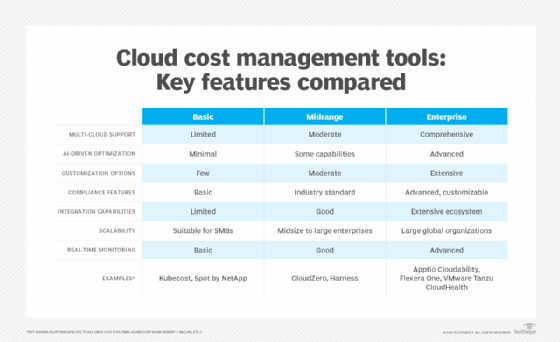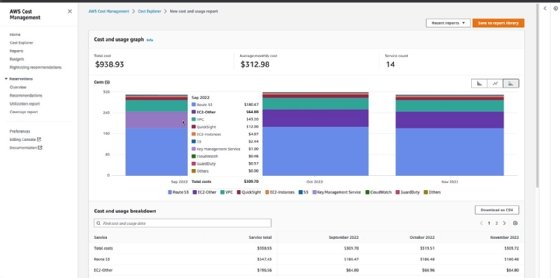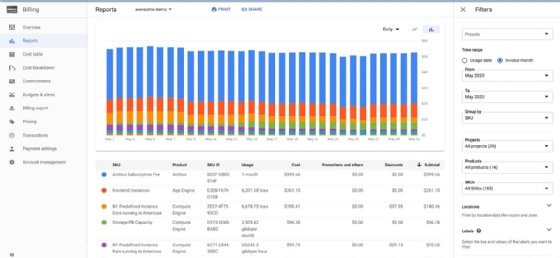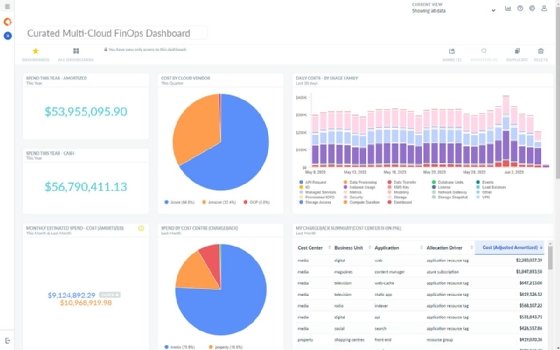9 cloud cost management tools you should know about
There's a whole category of tools dedicated to managing cloud costs. Here's how they optimize cloud resources and improve bottom lines, plus descriptions of nine of the best ones.
Cloud computing has become essential for modern IT, but managing cloud costs is a growing challenge. The ease of adding cloud resources and complex pricing models of the public cloud often lead to unexpected expenses. According to the "2024 State of the Cloud Report" from Flexera, a vendor of IT asset management software, 29% of respondents spend more than $12 million a year on cloud services.
Cloud cost management tools offer a solution, providing visibility, control and optimization capabilities. These tools help organizations transform their approach to cloud investments, bridging the gap between cloud chaos and control. This guide explores the benefits, features and top cloud cost management products that are relevant for businesses of all sizes.
What is cloud cost management?
Cloud cost management is a crucial strategy for monitoring, analyzing and optimizing expenses related to cloud resources. It involves cost management tools and practices that help organizations control cloud spending and maximize the value of their investment in cloud services.
This approach goes beyond simple accounting, aligning cloud use with business objectives to ensure every dollar contributes to organizational goals. As businesses increasingly rely on public cloud platforms, effective cost management becomes a critical competency that bridges IT operations and financial management.
This article is part of
What is cloud management? Definition, benefits and guide
Key components of cloud cost management include the following:
- Visibility. Real-time views of all cloud resources and their costs across providers and accounts.
- Cost allocation. Attributing costs to specific departments, projects or applications.
- Optimization. Identifying waste, right-sizing resources and implementing cost-saving options.
- Forecasting. Predicting future cloud costs based on historical data and growth projections.
- Governance. Implementing policies and controls to manage and optimize cloud infrastructure and prevent overspending.
- Automation. Using tools to automatically adjust resource allocation based on usage patterns.
By implementing these components, organizations can transform their approach to managing cloud resources. Adopting a proactive stance not only helps control costs but also maximizes the value derived from cloud investments.
As public cloud use continues to grow, mastering cloud cost management becomes both a financial imperative and a key driver of competitive advantage in the digital economy. It enables organizations to make informed decisions about resource allocation and capacity planning, ensuring they remain agile and efficient in an increasingly cloud-centric business landscape.

What are the benefits of cloud cost management?
Getting a handle on cloud costs provides a number of benefits.
Enhancing cloud financial visibility
Effective cloud cost management provides unparalleled visibility into cloud expenditures, eliminating guesswork and preventing unexpected end-of-month surprises. This capability offers real-time insights into cost data, immediate anomaly detection and data-driven decision-making.
Optimizing resources for maximum efficiency
Cloud cost management tools act as efficiency consultants, identifying idle resources, optimizing over-provisioned resources, uncovering cost saving opportunities and ensuring maximum return on cloud investments. This results in a streamlined, cost-effective cloud environment that maximizes value.
Turning forecasting into a science
As Peter Drucker famously said, "The best way to predict the future is to create it." With cloud cost management, organizations can move beyond mere predictions to actively shaping their financial future. Advanced analytics and machine learning algorithms analyze historical data and growth trends, providing accurate forecasts that transform budgeting from guesswork into strategic planning.
Aligning IT with business goals
Cloud cost management serves as a critical link between IT operations and business strategy. By mapping cloud costs directly to business initiatives, quantifying IT's impact on financial outcomes and justifying investments through data-driven insights, cloud cost management shifts the perception of IT from a cost center to a strategic value driver.
Empowering engineers with financial insight
Providing engineers with visibility into the financial impact of their decisions fosters a culture of cost-conscious innovation. Such an environment promotes collaboration where both efficiency and creativity thrive, making cloud cost management a catalyst for organizational transformation.
Cloud cost management extends beyond mere cost-saving measures: It can revolutionize cloud operations across the organization. By empowering finance and engineering teams alike, it contributes to a leaner, more agile and competitive business. In today's digital economy, such capabilities are not just beneficial. They are essential.
Key features of cloud cost management tools
Modern cloud cost management tools offer several key features:
- Real-time cost monitoring provides an up-to-the-minute view of cloud spending, allowing organizations to identify unexpected spikes in use, track spending against budgets and make informed decisions about resource allocation in multiple cloud environments.
- Cost allocation features attribute expenses to specific departments, projects or applications. Such granular insight is invaluable for accurate budgeting and forecasting. Effective tagging strategies help create a clear financial map of cloud infrastructure.
- AI-driven recommendations can significantly reduce cloud spend by identifying idle or underused resources, opportunities for right-sizing cloud instances and potential savings through reserved instances or savings plans.
- Multi-cloud support enables unified dashboards for all of an organization's cloud services, consistent reporting across platforms and comparative analysis to optimize multi-cloud deployments.
Benefits of advanced budgeting and forecasting
The advanced budgeting and forecasting features in many cloud cost management tools use historical data and machine learning to project future expenses, allowing organizations to do the following:
- Set realistic budgets based on expected growth.
- Identify potential cost issues before they occur.
- Align cloud spending with overall business objectives.
- Adjust resource allocation proactively.
- Improve long-term financial planning.
Anomaly detection algorithms can spot unexpected increases in cloud resource usage, identify potential security breaches that may impact costs and alert relevant team members to take prompt action.
Customizable dashboards and reporting features allow organizations to create role-specific views, focus on the most important metrics and generate reports that align with organizational structure.
Choosing the right cloud cost management tool
Choosing the ideal cloud cost management tool is crucial for your organization's cloud strategy and bottom line. Consider these key factors when evaluating options:
- Compatibility with existing cloud infrastructure.
- UI and ease of use.
- Scalability to meet future demands.
- Security and compliance features. They are non-negotiable and including the following:
- End-to-end encryption.
- Role-based access control.
- Audit trails.
- Compliance reporting.
- Regular security updates.
- Built-in integration capabilities with cloud providers and other systems, plus the ability to connect with existing infrastructure.
- Total cost of ownership.
Remember, the best tool aligns with your organization's specific needs, cloud strategy and growth plans. Thoroughly evaluate options, involve key stakeholders, and request demos or trials before making the final choice.
By carefully considering these factors and weighing them against your unique requirements, you'll be well positioned to select a cloud cost management tool that controls costs in the short term and supports your long-term cloud strategy and business objectives.
Top cloud cost management tools to know
The variety of cloud cost management tools available today offers solutions for organizations of all sizes and cloud maturity levels. When choosing a tool, consider your specific cloud environment, budget constraints and long-term strategic goals. The right tool will not only help control costs but also provide insights that drive informed decision-making about cloud investments. As cloud technologies evolve, stay alert to new features and emerging tools that could further optimize your cloud spending and align it with business objectives.
Several tools have emerged as leaders in helping organizations manage cloud costs and optimize their cloud financial management. Here's a look at some of the top tools. The products were chosen based on market presence, unique features and reports from industry analyst firms, including Forrester and Gartner.
AWS Cost Explorer
AWS Cost Explorer is a powerful tool written specifically for the AWS platform, and powered by AWS Compute Optimizer for organizations that are deeply integrated with AWS services. Its seamless integration with other AWS offerings makes it an excellent choice for businesses looking to optimize their AWS spending without adopting third-party tools.

Key features and differentiators:
- Detailed cost breakdowns by service, region and usage type.
- Customizable reports and dashboards.
- Reserved instance recommendation engine.
- API access for programmatic cost analysis.
Ideal use cases:
- Organizations heavily invested in the AWS ecosystem.
- Businesses seeking native integration with AWS services.
- Companies looking for granular AWS-specific cost insights.
Azure Cost Management + Billing
Azure Cost Management + Billing offers comprehensive cost management capabilities for Azure users, with the added benefit of supporting AWS cost analysis. Its integration with other Microsoft tools makes it particularly valuable for organizations invested in the Microsoft ecosystem.
Key features and differentiators:
- Unified cost management for Azure and AWS.
- Cost allocation and chargeback capabilities.
- Integration with Azure Advisor for optimization recommendations.
- Microsoft Power BI integration for advanced reporting.
Ideal use cases:
- Organizations primarily using Microsoft Azure.
- Businesses with hybrid or multi-cloud environments including Azure.
- Companies seeking rigorous cost forecasting and budgeting tools.
Google Cloud Cost Management
Google Cloud Cost Management takes advantage of Google's strengths in data analysis and machine learning to provide insightful capabilities to manage cloud costs. It's particularly well suited for organizations that value data-driven decision-making in their cloud cost optimization efforts.

Key features and differentiators:
- Detailed billing reports and customizable dashboards.
- Recommendations for cost optimization and right-sizing.
- Integration with Google Cloud Platform's BigQuery data warehouse for advanced cost analysis.
- Support for multi-cloud environments.
Ideal use cases:
- Organizations primarily using Google Cloud Platform.
- Businesses looking for AI-driven cost optimization recommendations.
- Companies requiring advanced data analysis of cloud spending.
CloudZero
CloudZero stands out with its focus on unit economics and its ability to provide cost insights without extensive manual tagging. Its approach is particularly valuable for SaaS vendors and other organizations seeking to understand the relationship between cloud costs and business outcomes.
Key features and differentiators:
- Unit cost analysis (e.g., cost per customer, feature or team).
- Anomaly detection and real-time alerts.
- Automated cost allocation capabilities, which may reduce the need for extensive manual tagging.
- Integration with DevOps tools.
Ideal use cases:
- SaaS vendors looking to understand their cost per customer and align cloud spending with business metrics.
- Any organization wanting to align cloud costs with business metrics.
- Teams looking for developer-friendly cost management tools.
Apptio Cloudability
Apptio Cloudability offers a comprehensive suite of cost management tools suitable for complex enterprise environments. Its focus on FinOps principles makes it an excellent choice for organizations looking to improve their cloud financial management practices.

Key features and differentiators:
- Multi-cloud cost management and optimization.
- Strong tagging and allocation capabilities.
- FinOps-oriented features for financial management.
- Predictive analytics for cost forecasting.
Ideal use cases:
- Large enterprises with complex multi-cloud environments.
- Organizations adopting FinOps practices.
- Businesses requiring advanced financial modeling of cloud costs.
VMware Tanzu CloudHealth
VMware Tanzu CloudHealth excels in providing a unified view of costs across multi-cloud and hybrid environments. Its strong integration with VMware's ecosystem makes it particularly valuable for organizations heavily invested in VMware technologies.
Key features and differentiators:
- Multi-cloud and hybrid cloud support.
- Customizable governance policies.
- Comprehensive rightsizing recommendations.
- Integration with VMware's ecosystem of cloud management tools.
Ideal use cases:
- Organizations with hybrid cloud environments.
- Enterprises seeking advanced policy-based governance.
- Businesses already using VMware products.
Flexera One
Flexera One stands out by combining cloud cost management with broader IT asset management capabilities. This integrated approach is particularly beneficial for organizations looking to optimize their entire IT spend, not just cloud costs.
Key features and differentiators:
- IT asset management integrated with cloud cost optimization.
- Automated discovery and inventory of cloud resources.
- License optimization for both cloud and on-premises software.
- Advanced what-if scenario modeling.
Ideal use cases:
- Large enterprises with complex IT environments.
- Organizations seeking to optimize both cloud and software licensing costs.
- Businesses requiring detailed IT asset lifecycle management.
Kubecost
Kubecost focuses specifically on Kubernetes environments, providing deep insights into container-related costs. Its Kubernetes-native approach makes it an excellent choice for organizations deeply invested in container technologies.
Key features and differentiators:
- Kubernetes-native cost allocation and optimization.
- Real-time cost monitoring for container environments.
- Integration with major cloud providers and Kubernetes distributions.
- OpenCost (open source version) available.
Ideal use cases:
- Organizations heavily using Kubernetes for container orchestration.
- DevOps teams seeking granular cost insights for microservices.
- Businesses looking for open source cost management options.
Spot by NetApp
Spot by NetApp, which was recently acquired by Flexera, specializes in optimizing cloud workloads through intelligent use of spot instances and reserved capacity. Its automation-focused approach is particularly valuable for organizations looking to maximize cloud efficiency without manual intervention.
Key features and differentiators:
- Automated cloud workload optimization.
- Spot instance and reserved instance management.
- Continuous workload rightsizing.
- CloudCheckr integration for comprehensive cost management.
Ideal use cases:
- Organizations looking to maximize savings through spot and reserved instances.
- Businesses with variable workloads that can benefit from dynamic optimization.
- DevOps teams seeking to automate infrastructure efficiency.
Best practices for implementing cloud cost management
By implementing a comprehensive cloud cost management strategy, businesses can achieve significant savings while maintaining performance and innovation. Here are three areas to focus on.
1. Fostering a cost-aware culture
Creating a culture of cost awareness is fundamental to successful cloud cost management. This involves educating teams across the organization about the impact of their decisions on cloud costs and empowering them to make cost-effective choices. Regular training sessions, incorporating cost considerations into the development process and promoting transparency in cloud spending are key steps in fostering this culture.
2. Continuous optimization: A cycle of improvement
Regular reviews and optimization efforts are essential for maintaining efficiency as your cloud use evolves. Focus on identifying underutilized resources, rightsizing opportunities and potential architectural improvements.
- Conduct weekly checks for anomalies or unexpected spikes.
- Perform monthly analyses of spending trends and optimization opportunities.
- Schedule quarterly reviews to align cloud spending with business objectives.
3. Harnessing AI and automation
The impact of AI and automation on cloud cost management can be substantial. Cost reductions of 20% to 30% are possible in the first few months. Resource optimization enables continuous adjustments based on usage, while AI-driven anomaly detection can help identify cost spikes in real time. Predictive analytics can help to forecast future spending and potential overruns. By employing these technologies, organizations can achieve ongoing cost optimization without compromising performance or reliability.
Implementing these strategies enables organizations to create a solid framework for cloud cost management that evolves with their cloud use, supporting business growth and innovation in an increasingly cloud-centric world.
Adam Bertram is an online entrepreneur, Microsoft MVP, trainer and content marketing writer for technology companies.








